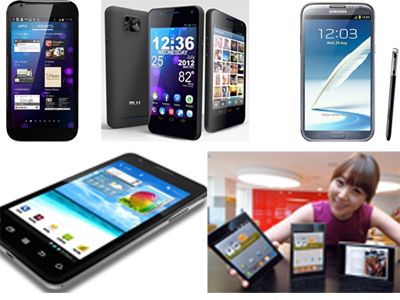Samsung has stressed that phablets, which is a hybrid between smartphones and tablets, are here to stay.
"We know, and we've proven very effectively, that consumers like big-screen phones," said Nick DiCarlo, Samsung's vice president of product planning. "Ours has the S Pen ecosystem: the pen, the digitizer, the SDK and the apps. We have more work to do to make that ecosystem as good as it can be."
So when does a product exceed the boundaries in terms of a phablet? "We'll find out when we find out!" DiCarlo laughed. "With the 7in Galaxy Tab, the number one complaint we had in the US market was that we didn't launch it with voice calling. That took me by surprise."
"The funny emotion for me now is how small the (4.8in) Galaxy S3 feels," he added. "One of the things I think will be happening through 2013 and 2014 is that hand-feel won't be the overarching conversation. It'll be the experiences you have on the device. [People are] going to watch so much more video on [their devices] that their behaviour of what they do with TV is going to change."
During CES 2013, Chinese handset manufacturer Huawei revealed the smartphone with the world's largest screen found on a phone in the form of the 6.1-inch Ascend Mate (our impressions on the device can be found here).
Samsung, meanwhile, has already tasted success in the phablet market with its 5.5-inch Galaxy Note 2, which sold over 5 million units during its first two months of availability. The device's successor, the Galaxy Note 3, is rumored to sport a 6.3-inch screen.
As evidently showcased during CES, 5-inch smartphones are expected to be more common in 2013.
Get Tom's Hardware's best news and in-depth reviews, straight to your inbox.

Zak Islam is a freelance writer focusing on security, networking, and general computing. His work also appears at Digital Trends and Tom's Guide.
-
ironmb I smile when i see a big 7 inch tablet next to someone's ear as they talk on it. I smile everytime.Reply -
halcyon What can we say? Well done Samsung...you've got my dollars . ...just make sure that Note 3 has no less than a 1080p screen and that thing you're calling an octacore.Reply
"The funny emotion for me now is how small the (4.8in) Galaxy S3 feels,"
...this is so true. I have the S3 (as well as my beloved Note II) and as nice as the S3 is it just seems so...so...small. :heink: -
hoofhearted More important, Samsung looks at what we like unlike other companies named after certain fruit that like to dictate that we should have a small screen.Reply -
@hoofhearted no one dictates what you have to buy!?!Reply
Personally, I think tablets and phones have their place. If you can't afford both, then maybe its nice to have the extra screen real estate when your using your phone for things like video which would be better suited to a tablet but I can afford both so I don't want to have to try and fit / cart around an oversized phone in my pocket! -
-Jackson What the hell is with you people and quad/octa cores in phones?Reply
The extra cores make no performacne difference whatsoever, but you seem to think otherwise.
Unless these phones are able to fold anytime soon, shut up about the cores. -
halcyon @ DRH, your points are valid, however, my situation wasn't that I couldn't afford to have a phone and tablet it was that I couldn't seem to get the same high-quality experience that I had on the S3 in a tablet, believe it or not. I tried what, at the time, should have been the reigning king, the Asus Transformer Infinity. Nope. The Samsung tablets aren't attractive to me because the screens are too low resolution for what I've become accustomed to (iPads) and too plasticky for my tastes (see Asus Transformer Prime/Infinity or iPad for what materials to use to build a tablet). ...so the Note II is as good as it gets for me...for now. We shall see what the future holds.Reply
-JacksonWhat the hell is with you people and quad/octa cores in phones?The extra cores make no performacne difference whatsoever, but you seem to think otherwise.Unless these phones are able to fold anytime soon, shut up about the cores.Your immature-sounding comment aside, I feel that the most capable mobile processors are more future-proof than the lesser capable ones. I have not taken the time to research this (nor will I) so I could be mistaken. I have a car with more HP than I can use too...but I don't feel that it was a waste. ...back to phones, my Note 2 with its 6200 mAh battery lasts over 3 days (implying the standard battery would last over ~1.5 days) so it doesn't seem that having a quad-core is hurtful.
Further, who knows what capabilities the next version of Android might have or whether or not it'll be a better multi-tasker or make better use of parallel processing. This thing Samsung is calling an "Octacore" that they've just brewed up is pretty power-efficient so why not? -
house70 halcyon@ DRH, your points are valid, however, my situation wasn't that I couldn't afford to have a phone and tablet it was that I couldn't seem to get the same high-quality experience that I had on the S3 in a tablet, believe it or not. I tried what, at the time, should have been the reigning king, the Asus Transformer Infinity. Nope. The Samsung tablets aren't attractive to me because the screens are too low resolution for what I've become accustomed to (iPads) and too plasticky for my tastes (see Asus Transformer Prime/Infinity or iPad for what materials to use to build a tablet). ...so the Note II is as good as it gets for me...for now. You should try the Nexus 10. It blows any iPad, and pretty much any other tablet available as to date, out of the water.Reply
-
halcyon ^ Thanks, I'll look and check it out but TBH I'm pretty happy with the Note II for now ...it's big enough to enjoy movies on but small enough to take anywhere.Reply
